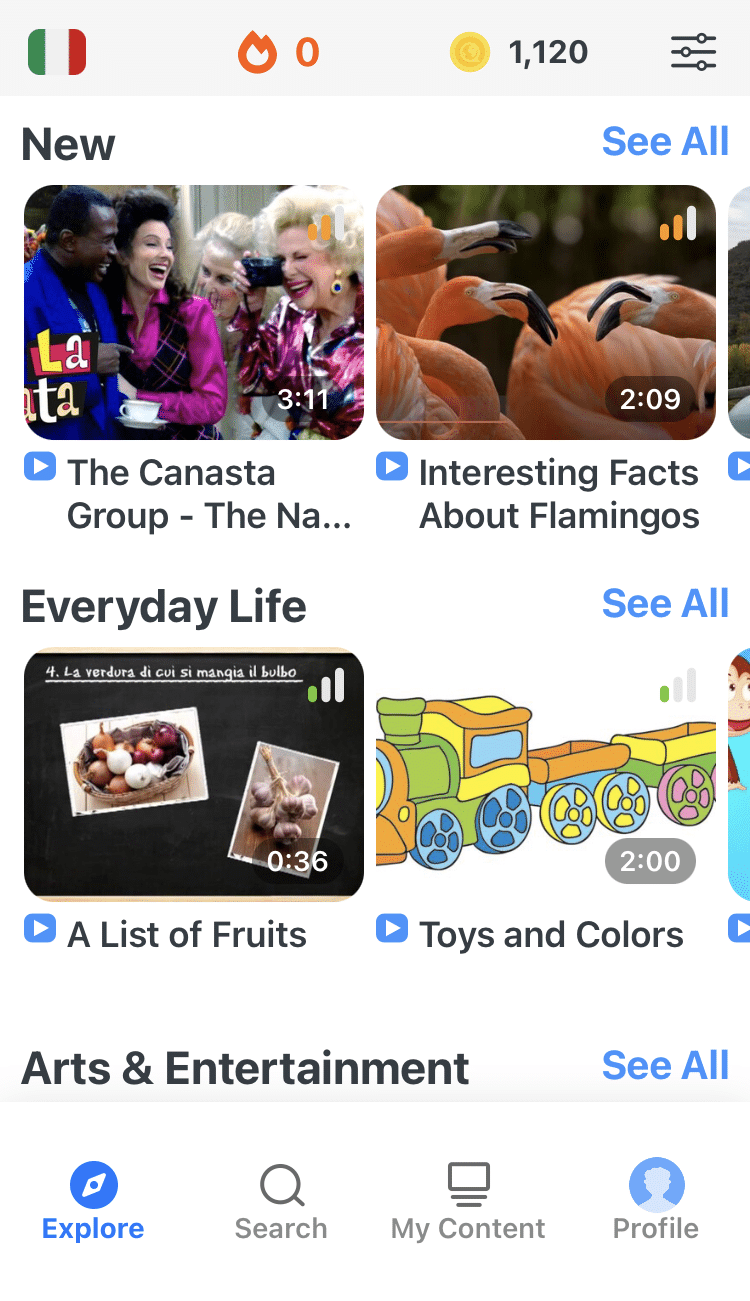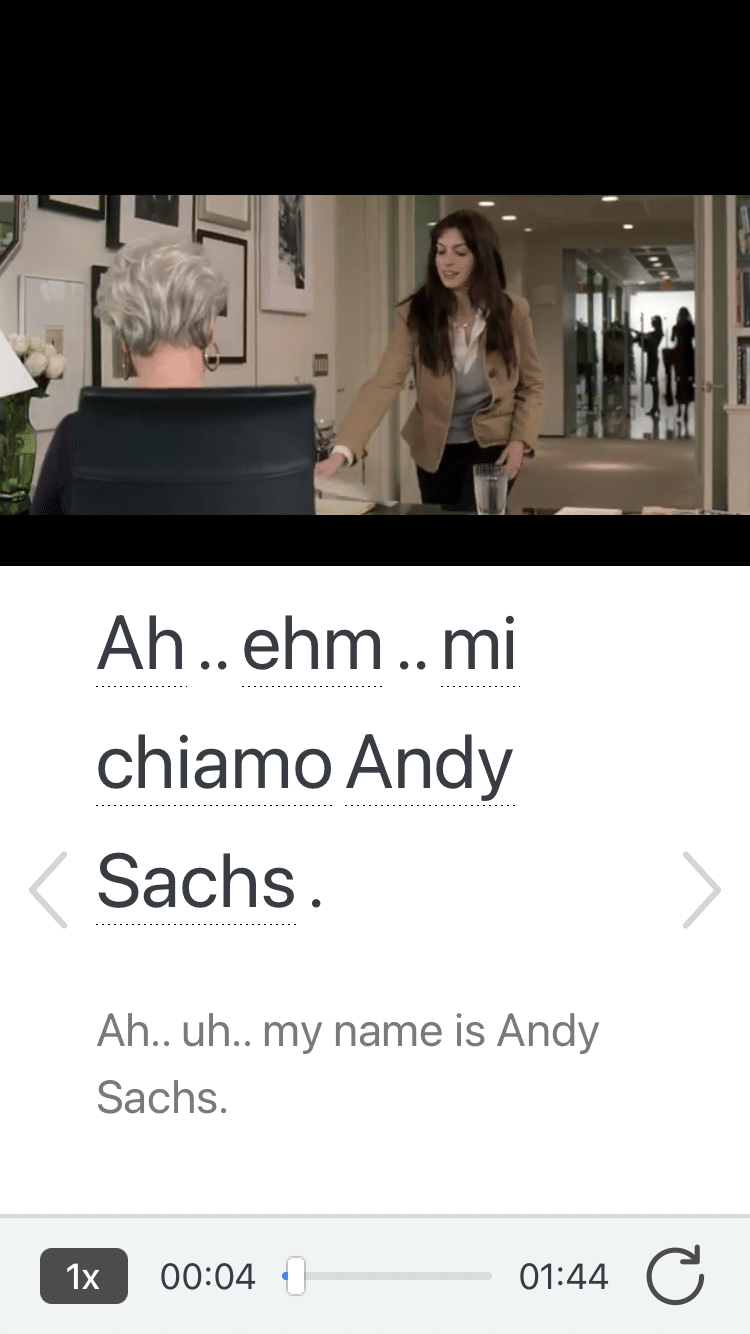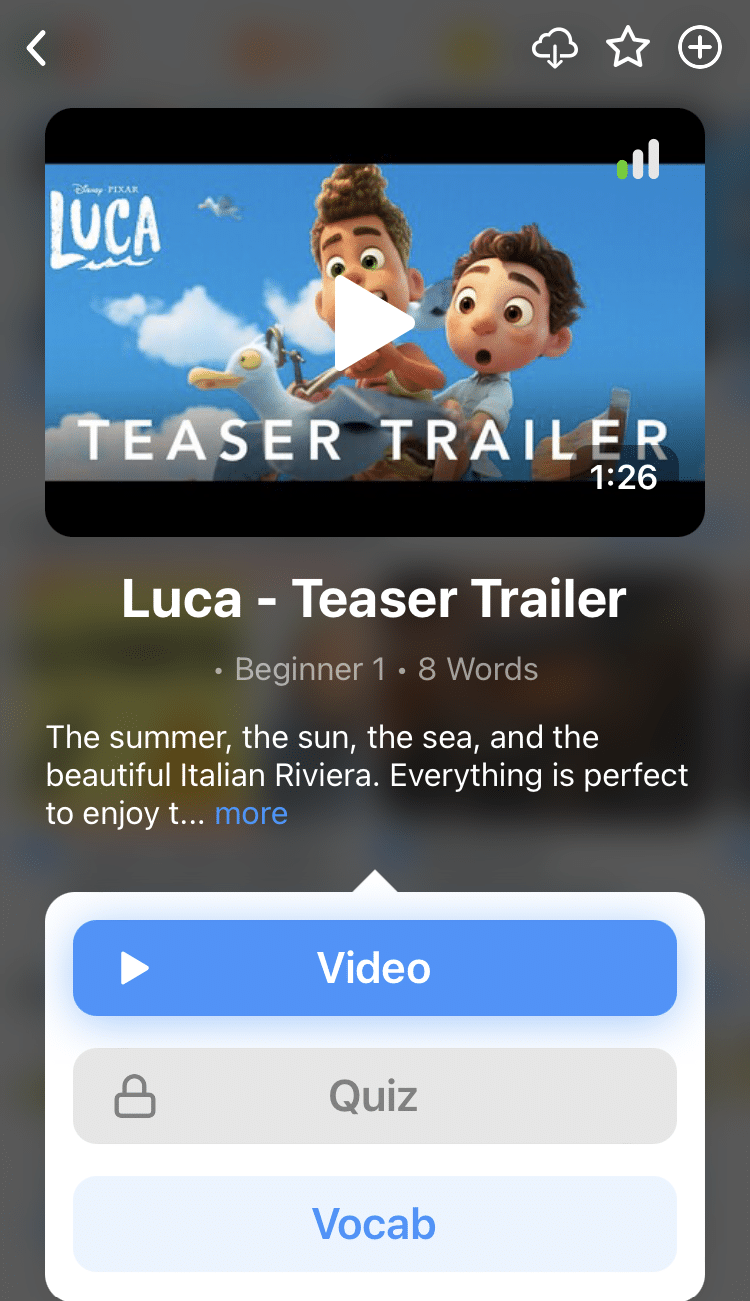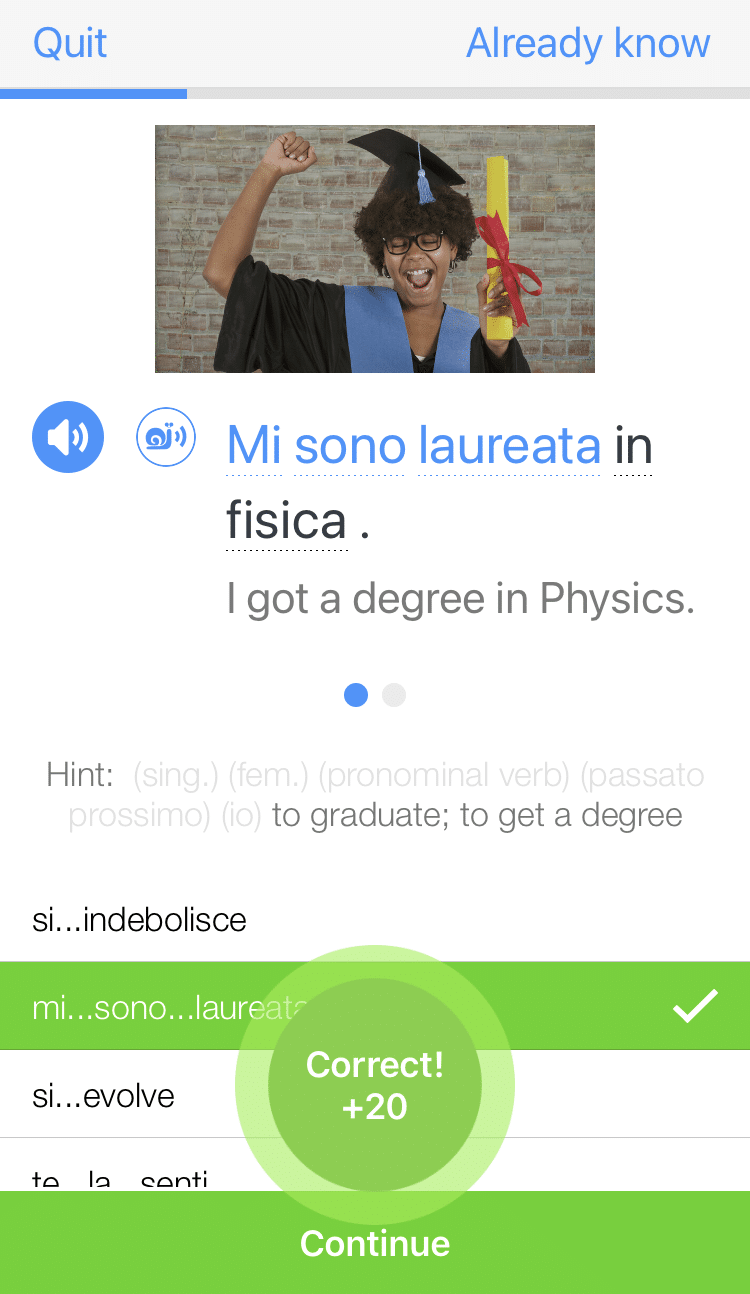
Conversational Italian: 5 Steps to Suave Speaking Skills
When you master conversational Italian, it can make a big difference in your handling of the language.
It’s one thing to write out Italian accent marks and another to say them out loud.
Of course, you want a safe space to practice your spoken Italian and get feedback (instead of snickers) in return.
So how do you do just that?
Lucky for you, we’ve put together some foolproof options in this post.
Contents
- What Constitutes Conversational Italian?
- 5 Ways to Master Conversational Italian and Sound Like a True Italian
- And One More Thing...
Download: This blog post is available as a convenient and portable PDF that you can take anywhere. Click here to get a copy. (Download)
What Constitutes Conversational Italian?
Before we get into the tips, let’s be clear on what conversational Italian is.
The Common European Framework for Reference of Languages provides some guidelines on how “conversational” should be defined.
Essentially, it says you can be considered conversational in a language even if your mastery of it is at the lowest level. Think of babies and their limited—but useful—vocabularies.
But how many words do you really need to be conversant—like an actual, narrowed-down and tangible number?
The truth is, there’s no one-size-fits-all vocabulary goal that determines if you’re conversational in a language.
It pretty much depends on how in-depth a speaker believes conversations should be.
Want minimal conversation? Less will do. In-depth? You’re going to need a bigger vocabulary for that.
What all this really means is you can be conversational at any level.
But if you really want to go beyond a superficial level when it comes to conversation, you’ll have to work on that. And that’s where this post comes in.
Without further ado, andiamo! (let’s go!)
5 Ways to Master Conversational Italian and Sound Like a True Italian
First, let’s assume you have your Italian language basics down. You’ve probably done some coursework, have a core vocabulary and are up-to-speed with fundamental grammar skills.
Now you’re ready to get moving!
1. Go Beyond the Basics
Starting to talk can be scary. Even if you can put together grammatically correct sentences, you might still feel unsure when you first dive into the language.
Here are three tips that’ll help you get started with spoken Italian:
Memorize Common Italian Phrases
All things considered, people are pretty predictable. We repeat ourselves a lot in the conversations we share every day.
We use the same common phrases to greet each other, talk about the weather, ask for directions, etc.
When you commit at least a few of these expressions to memory, you open up lots of opportunities for casual conversations.
While there are cultures that avoid small talk, Italians love it. So most conversations (especially between people who don’t know each other) have some polite chit-chat at the beginning. Even corporate meetings start with small talk and pleasantries before getting down to business.
That said, it’s also important to know what level of respect you should use. Like many other languages, the words you use change depending on the level of formality of the conversation.
For example, here are some phrases you’ll usually hear in Italian. As you can see, some of them apply only to formal or informal situations, while others can apply to both.
| English Phrase | Formal Italian | Informal Italian |
|---|---|---|
| Hello | Buongiorno | Ciao *Buongiorno can also be used in informal contexts |
| Good evening | Buonasera | Buonasera |
| Good night | Buonanotte | Buonanotte |
| You | Lei | Tu |
| How are you? | Come sta? | Come stai? |
| Fine | Bene | Bene |
| Very well, thank you | Molto bene, grazie | Molto bene, grazie |
| Bad | Male | Male |
| And you? | E lei? | E tu? |
| What is your name? | Come si chiama? | Come ti chiami? |
| My name is... | Mi chiamo... | Mi chiamo... |
| Where do you come from? | Da dove viene (Lei)? | Da dove vieni (tu)? |
| I come from... | Vengo da... | Vengo da... |
| Goodbye | Arrivederci Arrivederla * *Very formal and somewhat outdated expression | Ciao |
| Excuse me | Mi scusi | Scusa |
| Please | Per favore Per piacere | Per favore Per piacere |
| Thank you | Grazie | Grazie |
| Thank you for your help | La ringrazio per il suo aiuto | Ti ringrazio per il tuo aiuto |
| You're welcome | Prego | Prego |
| I'm sorry | Mi dispiace | Mi dispiace |
| Sir | Signore | Signore |
| Madame | Signora | Signora |
| Miss | Signorina | Signorina |
Keep in mind that there are many topics that come up in a “wild” Italian conversation, so having a good mastery of Italian vocabulary would be great.
Learn Some Italian Idioms
Idioms are your best friend. They’re usually phrases that have meanings different from their literal translation like “It’s raining cats and dogs!” As you can imagine, native speakers often use them in daily conversation.
One good example is in bocca al lupo (literally “into the mouth of the wolf), which you say to someone when you want to wish them the best of luck. There’s a lot more where Italian idioms like that come from!
Learn Italian Slang
Of course, not all conversations will be formal. You’ll also need to be able to use and recognize slang. You wouldn’t want to accidentally use them in a context where they wouldn’t be appropriate!
For example, certain words like like mannaggia (damn) or che cavolo (what the heck) is best reserved for conversations with your new Italian friends at the bar, not with the local priest.
Of course, slang doesn’t end there. Check out this article on common Italian slang words to learn phrases that will make your conversations sound more natural. You can also watch these two videos.
Use Italian Filler Words
Filler words include “um,” “like” and “so.” You probably use them in English (hopefully not too often!) as a way to keep conversations going without dead air.
By learning some Italian filler words, you can sound Italian even while you’re trying to remember how to say that one word that’s on the tip of your tongue. For example, you can emphasize a point by saying proprio (really).
Master Italian Word Stress
If nothing else, Italian is perhaps best known for the rhythm of its language.
Unlike other languages like English or Russian, word stress and intonation in Italian is very regular. It might prove difficult to keep up with a conversation if you don’t recognize it. And if you don’t master it yourself, your Italian can be jarring to native speakers.
As a general rule, word stress generally falls on the penultimate (second-to-last) syllable. For example, the stress is on the second syllable in the word ragazzi (guys), so we get something like ra-GAZ-zi.
However, if a word has an accent mark, such as sì (yes) or caffè (coffee), stress is put on that syllable instead of following the stress rule.
Of course, there are plenty of exceptions such as macchina (car) where the stress is on the first syllable (MAC-chi-na).
To practice word stress, I suggest checking out some Italian podcasts or native Italian speech on YouTube (like Learn Italian with Lucrezia). I also recommend Forvo, where you can look up individual Italian words and hear them pronounced by native speakers.
Alternatively, you can use sites like One World Italiano, ItalianPod101 and Babbel—the last two of which we’ve reviewed here and here, respectively. They have both written and video materials—the perfect way to hear how phrases and words are actually pronounced.
2. Use Authentic Resources
Let’s face it: Conversational language isn’t always the same as textbook language.
Fill the gaps in your knowledge with authentic Italian resources to give you a better idea of how Italian speakers really speak.
Authentic immersion will help you soak up the language naturally and give you a better sense of what real Italian conversations sound like.
Luckily, you don’t have to fly to Italy or even leave home to create your immersive Italian space.
A program like FluentU, for example, helps you jump into the immersion zone by using an array of Italian videos.
FluentU takes authentic videos—like music videos, movie trailers, news and inspiring talks—and turns them into personalized language learning lessons.
You can try FluentU for free for 2 weeks. Check out the website or download the iOS app or Android app.
P.S. Click here to take advantage of our current sale! (Expires at the end of this month.)
Another way you can focus on immersion is by dedicating an hour each day to only using Italian. You can do this by reading books, watching movies or even speaking with your loved ones only in Italian.
3. Sing Along to Italian Tunes
Dust off those vocal chords, turn up the Italian music and sing!
Not only is singing fun, but it also gives you a feel for word order and cadence. Depending on your musical selections, it can also be a superb way to pick up idiomatic expressions.
You can find sing-along tunes on YouTube channels like the aptly-named “Italian sing-along songs.” It may only have a little over a dozen songs as of this writing, but what’s there will test both your linguistic and vocal chops.
If you’d like to listen to what Italy’s listening, many Italian radio stations live stream online. Tune in to a popular music station and belt your heart out!
4. Read Italian Aloud
Reading out loud may seem like an odd way to get into conversational Italian.
But think about it: the more comfortable you are when speaking words in your target language, the more likely you’ll want to engage in the activity. And the more engaged you are, the easier the process becomes.
So any effort at speaking Italian counts towards building conversational skills!
Read Short Stories
 You don’t need to read anything too literary at this point. Reading something short works just as well as reading a full-length novel.
You don’t need to read anything too literary at this point. Reading something short works just as well as reading a full-length novel.
As for me, I love short stories. I can read them in one sitting, and due to their length, they usually have plots that move pretty quickly. I don’t have to worry about extra words or long, involved explanations—just dialogues I can model!
One great resource is “Italian: Short Stories for Beginners.” As an added bonus, this volume comes with audio readings of the stories, so you can practice shadow reading—that is, reading along with the audio and matching the pronunciation and cadence.
Get Started with Children’s Books
 If your reading skills still need some work, consider reading Italian children’s books. They’re great confidence builders—and like short stories, tell a tale without dragging things out.
If your reading skills still need some work, consider reading Italian children’s books. They’re great confidence builders—and like short stories, tell a tale without dragging things out.
For example, you can start with something familiar like the Italian version of “Peter Rabbit and other Stories” by Beatrix Potter. Using your knowledge of the stories and the characters, you can easily deduce the meaning of the words you come across as you read.
Like my last selection, it’s also in audiobook format, so you can hear the words said out loud by a native speaker.
5. Just Speak!
It bears repeating: if you want to master conversational Italian, speak Italian as much as you can, as often as you can and with as many people as you can.
If you don’t have anyone to speak to, talk back to the television.
I’m not kidding—there’s a real benefit to responding to characters on TV shows and movies.
Or, if you’re not ready to formulate replies, just try repeating what’s being said. Choose a character, echo their dialogue and pretend you’re conversing with the other characters. It’ll give you practice in the fine art of speaking and responding.
Of course, it’s even better when your conversation partner actually talks back!
Fortunately, there are several ways to find language learners or native speakers for conversation practice. Here are a few options:
Tandem
Tandem is a language exchange site that offers speakers a chance to connect and speak Italian any time they have a few minutes to spare.
Native speakers from across Italy are available, so if you’re interested in learning a particular dialect or culture, choose a partner who’ll be happy to share those things with you.
Message, chat and talk using this free service and get your conversational skills moving!
Here’s a complete review of Tandem.
Conversation Exchange
This is a great place to find language partners from across the globe. Granted, not all of them are native speakers, but there are enough options that if you prefer authentic conversation, you’ll likely find it.
Or, if you’re more comfortable speaking with a learner like yourself, there are options available for that, too!
Member profiles often indicate details like their preferred method of conversation. Some want to Skype or chat, while others would rather have face-to-face conversational practice.
Chiacchieriamo (Instantly Italy)
The owner and teacher of this site, Cinzia, lives in Italy and will chat with you (over Skype) about all things Italian. Of course, she’ll also help you grow your conversational skills in a lively, friendly manner.
Cinzia offers a free 30-minute first conversation to see if it’s a good fit. What’s not to love?
italki

Essentially, you can use it to hire tutors for as little as US$5-6 per lesson. Note that the rate is for the trial lesson(s), and it will likely go up as you go farther along in your Italian language journey.
The great thing about having a tutor is you can hear Italian as it’s used by native speakers. You can also get real-time (and hopefully constructive) feedback on your spoken Italian.
Find out more about the ins and outs of italki here.
To gain conversational fluency in Italian, the biggest thing you have to do is speak a lot and as often as possible.
Your conversations will become more involved, less superficial and definitely more interesting as your skill set grows.
So use some of these handy hints, have some fun and grow your Italian to build conversational skills that’ll have you chatting like you were born on Sicily!
Buona fortuna! (Good luck!)
Download: This blog post is available as a convenient and portable PDF that you can take anywhere. Click here to get a copy. (Download)
And One More Thing...
If you're as busy as most of us, you don't always have time for lengthy language lessons. The solution? FluentU!
Learn Italian with funny commericals, documentary excerpts and web series, as you can see here:

FluentU helps you get comfortable with everyday Italian by combining all the benefits of complete immersion and native-level conversations with interactive subtitles. Tap on any word to instantly see an image, in-context definition, example sentences and other videos in which the word is used.

Access a complete interactive transcript of every video under the Dialogue tab, and review words and phrases with convenient audio clips under Vocab.

Once you've watched a video, you can use FluentU's quizzes to actively practice all the vocabulary in that video. Swipe left or right to see more examples of the word you’re on.

FluentU will even keep track of all the Italian words you’re learning, and give you extra practice with difficult words. Plus, it'll tell you exactly when it's time for review. Now that's a 100% personalized experience!
The best part? You can try FluentU for free with a trial.
Start using the FluentU website on your computer or tablet or, better yet, download the FluentU app from the iTunes or Google Play store. Click here to take advantage of our current sale! (Expires at the end of this month.)







